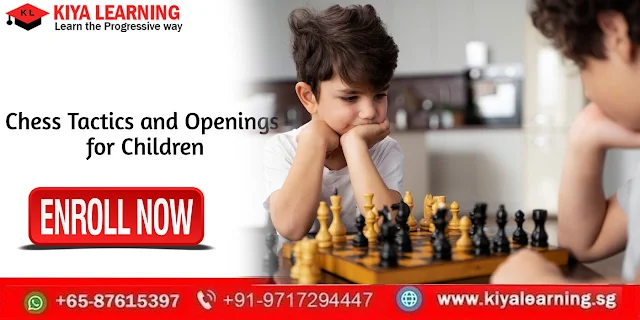Chess Tactics and Openings for Children
Chess is not just a game—it’s a
brain-boosting journey for children that enhances critical thinking, planning,
memory, and concentration. At Kiya Learning,
we believe in nurturing young minds through engaging and educational
strategies, and chess is one of the most powerful tools for cognitive
development. Chess
Classes in Singapore One of the best ways to help children improve in chess
is by teaching them tactics and openings in a simple, fun, and
structured way.
This blog will guide parents and
young learners through important chess tactics, tactical patterns, and the best
ways to practice them for long-term growth.
What
are Chess Tactics?
Chess Classes in
Singapore tactics are short-term maneuvers or combinations of moves that
players use to gain an advantage—like winning material or delivering checkmate.
While strategies involve long-term planning, tactics are more about spotting
opportunities in the moment.
For children, learning tactics early
on builds a strong foundation for playing smarter games. Common tactical themes
often come up repeatedly in chess games, so training children to recognize them
is crucial for their improvement.
Tactics typically involve forcing
moves, like checks, captures, or threats that the opponent must respond to.
This makes tactics easier to practice and learn compared to strategy, which can
be more abstract for young minds.
Important
Chess Tactical Patterns
Here are some beginner-friendly
tactical patterns every child should learn:
1.
Fork
A fork is when one piece attacks two
or more enemy pieces at the same time. Knights are especially known for
creating forks, but queens and pawns can do it too.
Example: A knight jumping into the center and threatening both the
king and rook.
2.
Pin
A pin happens when a piece can’t
move without exposing a more valuable piece behind it. This is often done using
a bishop or queen.
Example: A bishop pinning a knight to the king, making the knight
immobile.
3.
Skewer
This is the reverse of a pin. The
more valuable piece is in front, and when it moves, a lesser piece behind it is
captured.
Example: A rook skewering the king and a rook on the back rank.
4.
Discovered Attack
A discovered attack occurs when one
piece moves out of the way, revealing an attack by another piece.
Example: Moving a knight to reveal a bishop's check on the king.
5.
Double Check
A powerful tactic where two pieces
give check simultaneously. It often leads to a checkmate or significant gain.
These patterns can be taught with
puzzle books, interactive chess boards, and digital apps to make learning
enjoyable.
Forcing
Moves in Chess
Forcing moves are those that force
your opponent to respond, narrowing down their choices. These are often:
- Checks
– Your opponent must respond to a check.
- Captures
– Taking a piece usually demands attention.
- Threats
– Especially when you’re threatening a high-value piece or checkmate.
Teaching children to look for
forcing moves every turn is one of the best habits to develop early. It
encourages them to observe the entire board and calculate ahead.
Learning
and Improving Chess Tactics Skills
At Kiya
Learning, we focus on progressive learning tailored to a child’s level.
Here’s how children can improve their chess tactics:
- Start Simple:
Begin with one-move tactics and gradually introduce two- and three-move
combinations.
- Use Visual Aids:
Diagrams, animations, and physical boards help children understand
tactical ideas more clearly.
- Play Puzzle Rush:
Short, timed tactics challenges keep kids engaged and sharpen their
skills.
- Explain the ‘Why’:
When reviewing puzzles, always explain why a move works and what the
opponent’s best response would be.
- Gamify Learning:
Turn solving tactics into a fun daily challenge with rewards to keep
motivation high.
By including tactical lessons in
regular chess practice, children begin to develop an instinct for spotting
opportunities in real games.
Best
Ways to Practice Chess Tactics
Here are some practical and fun
methods to make chess
Classes in Singapore tactics practice part of your child’s routine:
✅
Online Tactics Trainers
Websites like ChessKid, Lichess, and
Chess.com offer age-appropriate puzzles that adapt to a child's level.
✅
Workbooks and Printables
Tactics workbooks are great offline
tools that help kids focus without screen distractions. These come with
increasing levels of difficulty and clear solutions.
✅
Daily Puzzle Time
Set aside 10-15 minutes daily for
tactics. Repetition is key, and small, regular practice builds memory and skill
over time.
✅
Play Mini Games
Mini games like “Knight vs Pawns” or
“Queen vs Rooks” help reinforce specific tactical ideas in a fun, interactive
way.
✅
Review Games Together
After each game, go over it with
your child and highlight missed tactics. This reflection builds awareness and
helps them learn from mistakes.
Bonus:
Beginner Chess Openings for Kids
Understanding basic openings helps
kids get into strong positions where tactics can thrive. A few kid-friendly
openings include:
- Italian Game (1.e4 e5 2.Nf3 Nc6 3.Bc4) – Simple, develops pieces fast.
- Scotch Game
– Encourages early central control.
- London System
– Safe and easy to understand setup for beginners.
Children don’t need to memorize deep
theory. Instead, focus on opening principles:
- Control the center.
- Develop pieces quickly.
- Castle early.
- Don’t move the same piece twice unnecessarily.
Final
Thoughts
Chess Classes in
Singapore tactics make the game
exciting and accessible for children. At Kiya Learning in Singapore, we blend
fun with focused learning, helping children not only understand tactics and
openings but also enjoy the game at a deeper level. With regular practice,
visual learning, and strategic play, young chess enthusiasts can dramatically
improve their skills—and have a great time doing it!
Whether your child is just starting
or already playing competitively, mastering tactics is the key to unlocking
their chess potential.
CONTACT US -
Instagram - https://www.instagram.com/kiyalearning/
Website URL - https://kiyalearning.com/
Business Email - contact@kiyalearning.com
Whataap Link - https://api.whatsapp.com/send/?phone=919717294447&text&type=phone_number&app_absent=0

Comments